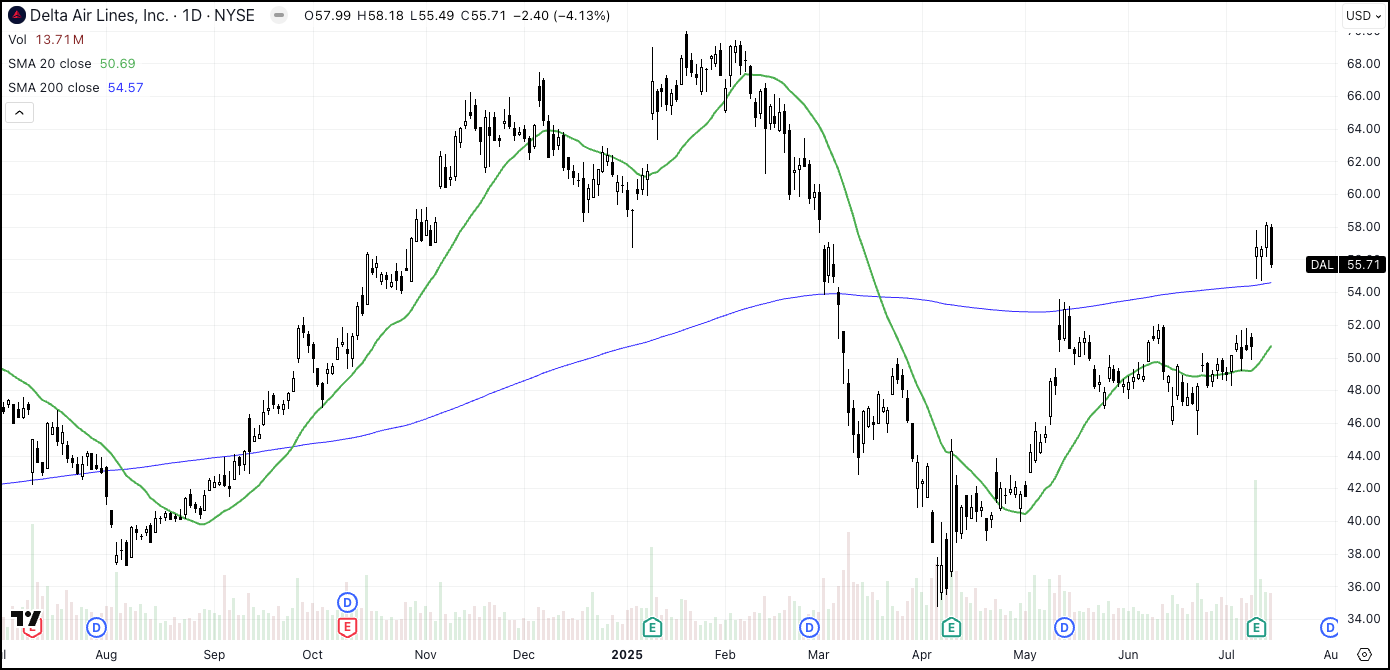DAL: Cash Flow at 30,000 Feet
While the market fixates on turbulence, Delta quietly delivers equity-bond stability backed by real free cash flow.
In the global economy, few industries are as indispensable and as cyclically exposed as commercial aviation. Airlines don’t just move people; they move markets, ideas, capital, and entire sectors of labor.
When the world is open for business, airlines hum at full throttle, fueling tourism, trade, and corporate connectivity. When conflict, inflation, or economic uncertainty hit, they’re often first to feel the turbulence. It’s a sector that reflects global sentiment almost in real time, hyper-sensitive to fuel prices, geopolitical instability, labor costs, and consumer confidence.
The paradox at the heart of the airline business is its place as a structural necessity in an economy that's more interconnected than ever in spite of its sensitivity. It’s also what makes it so interesting from a contrarian investor’s perspective. Current conditions are a cash in point, as airlines find themselves caught between improving fundamentals and lingering market distrust.
Delta Air Lines (DAL) is a prime example of that disconnect. On one hand, you’ve got the expected fears: rising input costs, global tensions, tariff headlines, and recession whispers. On the other, there’s the company’s actual financial trajectory, marked by cash generation, thoughtful debt reduction, and a re-established dividend. Despite those strength, the market doesn’t seem to fully believe the recovery is real or durable.
That skepticism is what creates the opportunity. The narrative around airlines often swings wildly between boom and bust; but as with most extreme stories, the truth usually lands somewhere in the middle.
The question isn’t whether Delta is protected from, or exposed to economic risk. It’s whether the stock's current valuation has already priced in a worst-case scenario that may not arrive. If that’s the case, is the market underestimating the company’s capacity to weather volatility and emerge leaner, more focused, and more cash-flow resilient?
As I think you'll see, DAL's setup right now isn’t about chasing momentum or betting on a travel boom. It’s about disciplined investing in a misunderstood cash engine, one that’s quietly rebuilding shareholder trust while the market waits for some louder signal to confirm what’s already happening under the hood.
The company isn’t perfect, and there are still real headwinds in place. When you step back and look at the balance sheet, the cash flow pattern, and the capital allocation strategy, you’re left with an intriguing puzzle: how long can the market keep pricing Delta like it’s still in survival mode, when the fundamentals suggest it’s already pivoted to stability and future growth? Let's dig in and try to answer that question.
Fundamental and Value Profile
Delta Air Lines (NYSE: DAL) is a major U.S. airline headquartered in Atlanta, Georgia. It operates over 5,000 flights daily to more than 290 destinations across six continents. Delta offers a range of services, including passenger and cargo transportation, in-flight entertainment, and vacation packages through Delta Vacations. The company generates revenue from passenger ticket sales, cargo services, and its SkyMiles loyalty program. Key growth drivers include strong demand for premium seating, corporate travel, and international routes, particularly transatlantic flights. DAL’s current market cap is about $36.38 billion.
Earnings and Sales Growth: Over the last twelve months, earnings declined by -11.02%, while revenue growth was flat, but slightly negative, at -0.06%. In the last quarter, earnings increased by 356.52% (not a typo), while sales also rose by 18.58%. The company’s operating profile has been narrowing earlier in 2025, but has swung to an impressive pattern of strength; over the last twelve months, net income was 7.24% of revenues, and increased to 12.79% in the last quarter.
Free Cash Flow: DAL’s free cash flow was about $2.33 billion over the last twelve months. That represents a decline from about $2.82 billion in the last quarter, but remains well above the $1.24 billion mark reported a year ago. The improvement in Net Income and Free Cash Flow can be attributed to accelerating premium and international travel demand and carefully controlled capacity. That included deferring delivery of new Airbus aircraft in anticipation of elevated tariff costs on European imports. Delta is unique among U.S. carriers, as they’ve responded to quality concerns related to Boeing by increasing their reliance on Airbus. They’re phasing out older 747 and 777 jets, and replacing them with the Airbus A350. Deferring those deliveries means maintaining older jets for a little longer while they wait for the tariff picture to become clearer.
Debt to Equity: DAL’s debt/equity ratio is .74, marking a steady decline from quarters prior when this ratio was above 1. In the last quarter, cash and liquid assets were a little over $3.33 billion, while long-term debt was around $12.83 billion. It’s worth noting that DAL has retired about $1.5 billion in long-term in the last year. The company’s operating profile and balance sheet are both good indications that servicing their debt is not a problem. Their sensitivity to interest rates is also somewhat mitigated, with limited near-term maturities in their current debt structure. DAL locked the majority of their existing maturities in 2020 and 2021 while rates remained at historical lows.
Dividend: DAL’s dividend is $.60 per share, which translates to an annualized dividend yield of 1.08% at the stock’s current price. DAL reinstated their dividend in the middle of 2023 after having suspended it in 2020 in response to pandemic-driven pressures, and then increased it from $.40 per share in July of last year. The yield sounds unimpressive, but the better story is the way DAL is conservatively rebuilding their dividend payout. It’s backed by approximately six years of free cash flow cover, and positioned to grow as economic stability recovers over time. It’s a pre-dividend-growth story that aims to rebuild its dividend quality the right way.
Price/Book Ratio: there are a lot of ways to measure how much a stock should be worth; but I like to work with a combination of Price/Book and Price/Cash Flow analysis. Together, these measurements provide a long-term, fair value target at around $272 per share. That means the stock is impressively undervalued, with nearly 388% upside from its current price. That sounds pretty far-fetched, to be sure, but it also means that continued strength toward the stock’s multi-year highs at around $71 is grounded in reality.
Technical Profile
Here’s a look at the stock’s latest technical chart.
Current Price Action/Trends and Pivots: The chart above displays DAL’s price action over the last year. From an April low at around $34, the stock has rebounded strongly, with a new surge in bullish momentum in the last week following the latest earnings report that saw the stock push above its blue, 200-day moving average line to mark current support at around $54.50, with immediate resistance at about $58. A push above $58 should see near-term upside to about $62.50, while a drop below $54.50 should see next support at around $52, based on pivot high activity seen in May and June around that level.
Near-term Keys: DAL offers a rare value setup in a sector still clouded by macro anxiety. While most investors focus on rising costs, tariff risks, or geopolitical noise, Delta’s fundamentals tell a different story: strong free cash flow, disciplined capital allocation, and a balance sheet that is steadily improving. The market remains cautious, but that is the opportunity. With conservative dividend growth underway, manageable debt, and a fair value well above current levels, DAL is quietly transitioning from recovery mode to long-term resilience. Risks remain, but for disciplined investors, the disconnect between perception and fundamentals makes this a high-conviction contrarian play.





